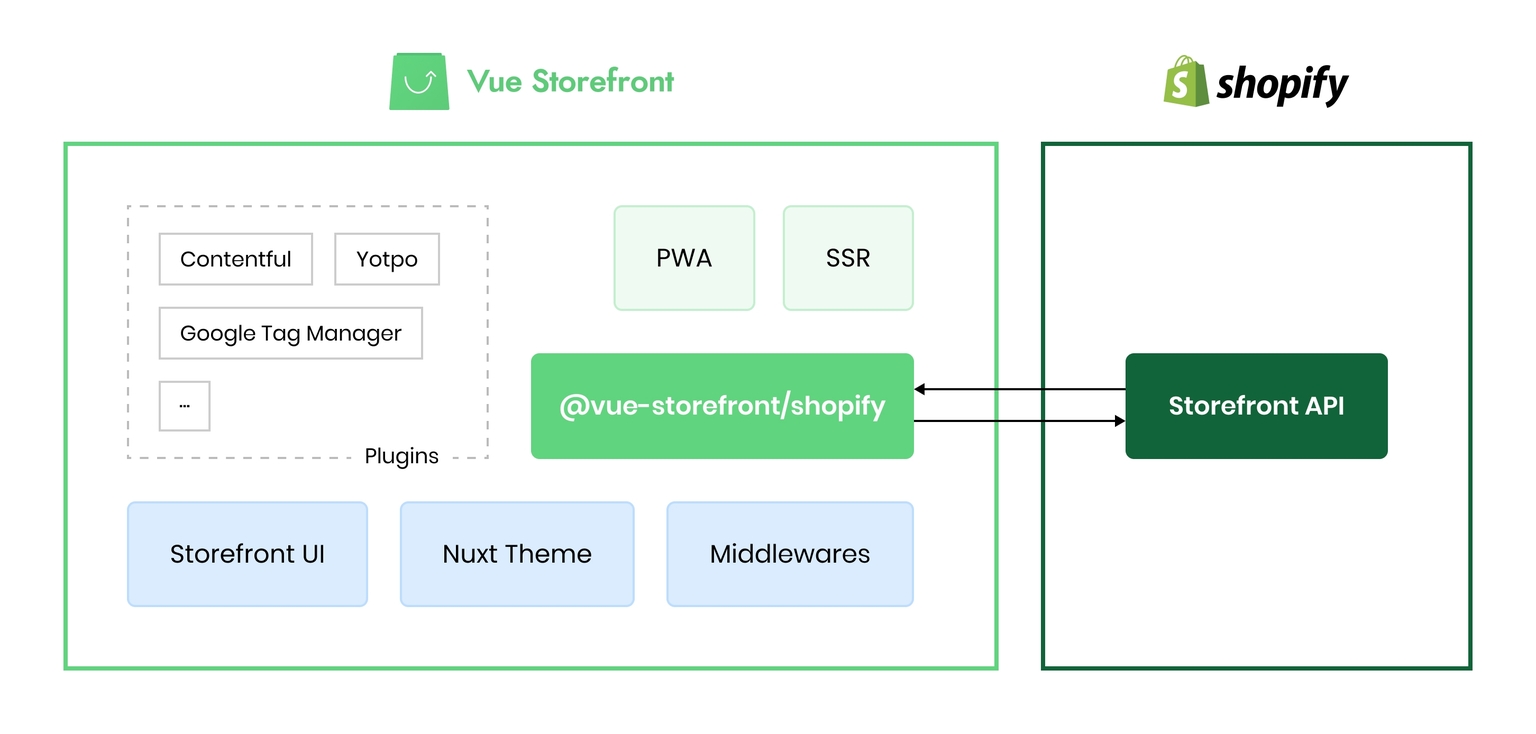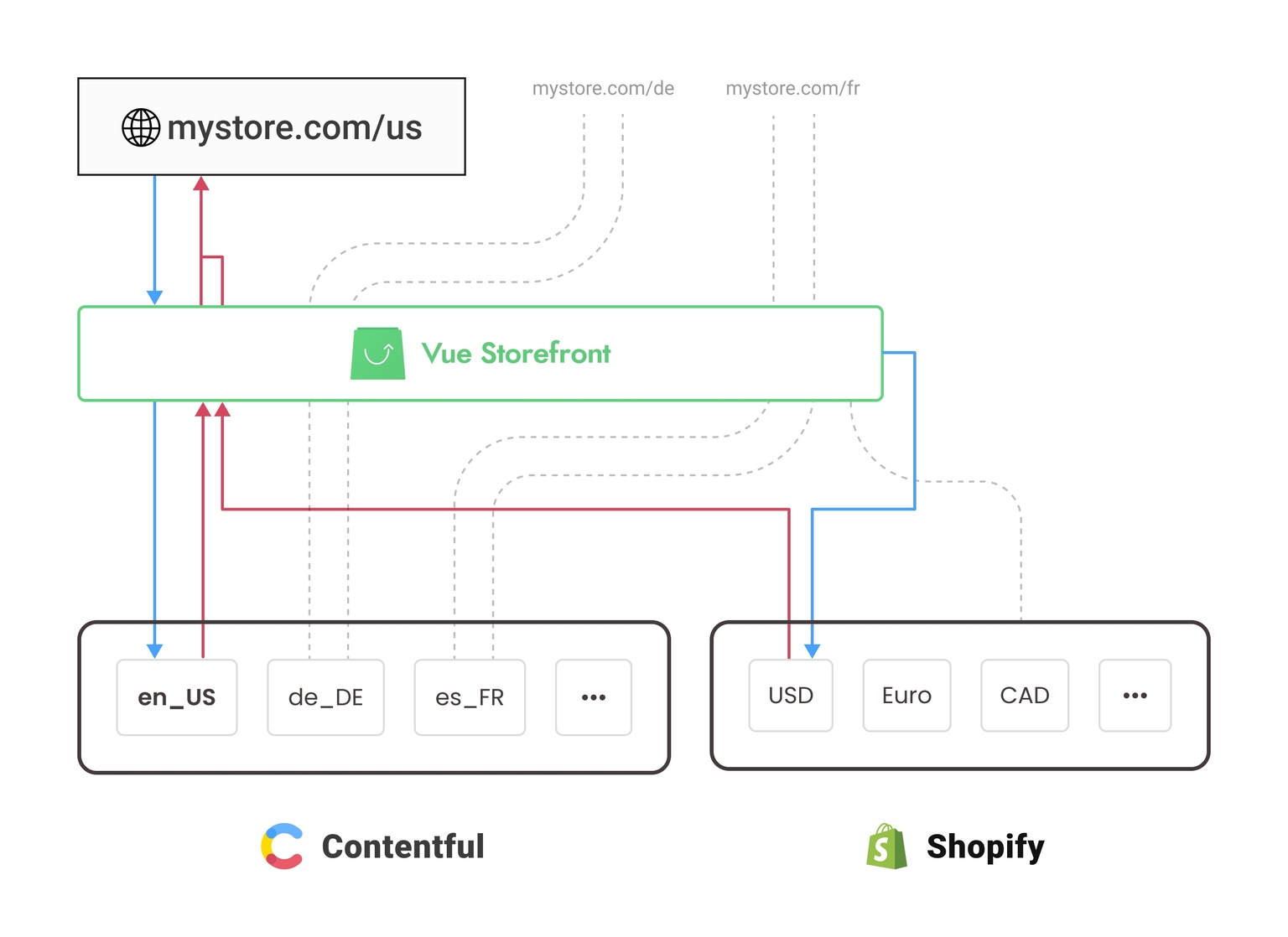Outstanding results achieved by Pure Daily Care when it went headless with Alokai had already proved that this is the right direction also for Shopify-based stores, but nothing would have happened without the Aureate Labs. This Alokai Core Partner is responsible for the Shopify Integration creation, and here is the story that will throw a light on how all of it was done.
Introduction
We have been helping our clients grow online, and we found that many of our Shopify clients were struggling to provide a great user experience, build for performance, and sell cross-border because of limitations pressed by Shopify.
Going headless was the only solution to break through the limitations of Shopify. But, unfortunately, we found no complete open source solution available in the market to build custom storefronts.
At the time we were already using Alokai for our Magento projects and we loved working with it. So we decided to make Shopify integration on the top of Alokai.
Now we look at Shopify + Alokai, and it’s a winning combination. We have total control over the frontend while using Shopify for the back-office operations, a win-win for all teams. Moreover, as it's open-source and backed by a vast community of developers waiting to contribute their time - eventually, this solution is set for dominance in the eCommerce world!
What is Alokai + Shopify Integration?
Alokai is a platform-agnostic e-commerce PWA frontend framework that can work with any e-commerce backend API. Shopify “Integration” is a package that connects Shopify and VSF2 using Shopify’s Storefront APIs. We are using Shopify JS Buy SDK under the hood.
This integration is built by keeping developers/agencies in mind. So they can use it as a “base” and add more customisations on top of it.

Here's a step-by-step guide to going headless in less than an hour
How does Shopify - Alokai Integration help merchants?
1. Building breakthrough experiences
With the rapid change in consumer buying patterns and customers buying more frequently from online stores, and a record number of new D2C stores going live everyday, the competition in the D2C space has heightened. With more choices to buy from, customers chose the stores which can deliver the best experience.
As technology continues to evolve, retailers need to keep up as well. Which means, providing a better customer experience is a necessity.
Nurturing customers is the modern version of marketing, and how customers feel when they are on your website matters the most. Customers pay more for a better buying experience, and it significantly improves retention rates.
While Shopify and Shopify themes are a great place to get started, they level the playing field for everyone, and their limitations prevent you from building great experiences.
Conclusion:
Using this integration, you don't have to think within the limits of Shopify. Instead, you can build what matters the most for your customers, and this integration makes you limitless. In addition, you can add any customisation you wish for.
For example, suppose you want to develop a custom layout for your flagship product or integrate 3rd party search and filter engines. In that case, Shopify's limitation won't be a problem now.
2. High-performing stores / PWAs
Mobile internet usage is rising at an alarming rate. With the average attention span of consumers shrinking, Website speed has become a factor that website owners need to consider. It directly affects your conversion rates, affecting your SEO and significantly affects your retention rate, reducing Customer Lifetime value. It can either make or break your business!
The default speed for a Shopify store is quite fast, but as soon as you add even a few apps, the speed slows down significantly, which means site visitors are more likely to bounce, increasing the bounce rate and thus increase your CPC if acquiring users through paid channels.
Shopify merchants, on average, have six applications installed on their store, which is enough to slow your store down - are you one of them?
Conclusion:
VSF+Shopify integration comes with PWA out of the box, so you can focus on what matters.
3. Hyper Personalisation
Hyper-personalization is the most advanced way brands can tailor their marketing and experiences for individual customers by using data, analytics, AI and automation.
Imagine going to a store which has exactly what you like, everything feels like it was made for you, but it looks very different to every user, that’s hyper-personalization.
Hyper-personalization has the power to deliver up to 800% ROI. According to an article from Deloitte, one out of five customers would share their data for companies to provide them with a personalized experience.
You can uniquely target your customers or deliver more personalised and relevant communications. There are many ways to do personalisation. For example, for product details page, you can personalise Recommendations, Recently Viewed Products, FOMO copy placing by observing customer behaviour, customised bestseller, etc.
Conclusion
Using open-source VSF+Shopify integration, you can customise stores that make most of the sense for your customers. Beyond customisation, you can integrate AI-based personalisation apps like Nosto or Dynamic Yield.
4. Freedom to experiments
It is very difficult to design or write for a specific audience with limited interaction with the audience, and this introduces biases and assumptions which can significantly affect your conversion rates. Running experiments and A/B testing can help you test, measure and remove biases.
Why worry if something will work or not? Just run the test on a segmented audience and verify if it does. It helps you accelerate decision making and increases confidence in the decisions taken.
Imagine the possibilities of what you could build with your website and how different it would look if those limitations didn’t exist. What part of your business do you want to grow? How can we make that happen for you today without worrying about whether or not Shopify will be able to handle what we need now, tomorrow, next year?
Running these experiments is very difficult or outright impossible to run on Shopify because many of these tools do not integrate with Shopify. However, when you build a headless solution using Integration, you break free of this limitation and experiment with ease.
Let me explain this by one use-case, which is not possible in traditional Shopify straightaway.
Example:
Hypothesis: If I add the “FAQ” section on the product detail page, it will increase the conversion rate
Solution:
- Imagine your frontend is hosted on VSF-Cloud and its behind Fastly CDN
- You can add FAQs on a particular PDP and only show it to users who has “qualified identifier” attached in X-Headers or Cookie (More info: https://developer.fastly.com/solutions/tutorials/ab-testing)
- You can do a deep integration of GA custom to identify which version is converting the most.
5. Sell across the border
When you grow faster on Shopify, it usually means that the time has come to open your business to new territories and take your business international.
Localisation with local language and showing their local currency, your global customers will feel more welcome, which can boost sales!
Shopify has limitations that prevent users from setting up a multi-language or currency store, but workarounds exist. Such as different setup stores for each language or using an application like Langify; both options come with complexity at the cost of performance and operations.
You can use Contentful or similar CMSs which integrate with VSF. Using Contentful’s Locale concept, you can add multiple entries for different languages. The below image will explain this concept succinctly.

6. SEO
It has no longer been a secret that SEO plays a vital role in eCommerce, makes the online brand/products discoverable within the competitive environment, and significantly reduces the CAC. However, with the perspective of headless architecture, the discoverable game has moved to the next level. It matches the Google algorithm of speed and page structure.
- Speed: With the implementation of the API-first strategy, content gets rendered within a fraction of a second, making the Shopify store lightning fast. Search engines incentivise websites that have a good customer experience and high performance.
- URL Structure: You can’t control the URL structure of products or categories or filtered URLs in Shopify, but when you go headless, you can define custom URL structure as per your need.
Undoubtedly, SEO spotlight on your headless Shopify store results in boosting business within the web rule book.
Things to know before going headless
Acclimating headless commerce frees you from the limitation, but it involves some facts you need to learn before you signal green for the deployment.
3rd party Apps: If you’re super comfortable with the Shopify App ecosystem where you can install any app within a few clicks, maybe headless is not for you because you need to make these apps (frontend facing apps, backend apps will work seamlessly) compatible with the frontend when you go headless all of these apps have to be custom developed for you.
Analytics: Shopify's reporting system might stop receiving signals the moment you go headless. However, all sales metrics will work seamlessly with no interruption to your data flow.
You, however, can get the same data in other Analytics tools like Mixpanel and Google Analytics.
Headless needs expertise: When you go completely free, you need something better than Shopify, which means you will have to hire experts who can build solutions better than the existing Shopify store.
Reskilling: Other than the back-office staff, marketing, analytics, merchandiser and managers will have to be reskilled into using the new tools to manage, analyse and operate the new headless store.
What is the cost of going headless?
Integrating headless architecture with Shopify is a broader solution to overcome marketing, analytics and UX limitations that prevent the business from growing. However, having an API-based model as the core for your business strategies enables the developers to be responsible and build the connection without affecting your current business model comes with a cost as well:
Implementation Cost
Headless projects are more expensive than normal Shopify builds. To avoid any risk and surprises, you need to have subject matter experts who can prepare a blueprint with final implementation details for the project without having them get in your way of production. Once this groundwork is done, it's time to hire expert developers who will do all the work smoothly.
VSF can save you time and money on implementation costs by delivering a fully functional out-of-the-box solution. This integration is designed with your needs in mind to keep your developers focused solely on 3rd party integrations, custom developer functions, or other desired features that are crucial for any business looking to launch its online store quickly.
Hosting & SSL Cost
You need to host Head outside of the Shopify ecosystem, which comes with the cost, but this will ensure you're in total control. The downside is that it requires a lot more work, and traditional Shopify takes care of SSL for you, so there are some added expenses involved.
Experts at VSF Cloud take care of server infrastructure for you, so you don’t need DevOps engineers in-house that will optimise your operating and management costs.
Other Cost
Successful brands constantly push the limits and add features to their stores to keep up with customer expectations. So you need developers/agencies on your team who can manage these for you and invest in a license of other third-party solutions like CMS, Search, Blog etc.
How is the cost of implementation justified?
Implementing Headless eCommerce helps you differentiate from others with a unique shopping experience. Headless commerce is customer-friendly and helps to delight customers, increase lifetime value, and convert more sales, bringing dynamic transformation and advocating ROI.
- Quick Go to Market: With the headless ecosystem, your Shopify store gets more efficient with workflows. The developers can work on multiple components simultaneously, which turns the work simultaneously. As a result, the occupancy of a developer is delivered in the shortest time with rollback updates and reaching the target customers.
The initial store takes longer to launch compared to a Shopify store, but everything else like launching a new product, running experiments, building new custom features have significantly faster go to market.
- Lower Customer Acquisition Cost: Thereformeduser experience generates personalised and interactional touchpoints which resonate and retain the visitors to be attentive on the web page for a longer time and force them to make a purchase.The seamless and smooth experience mottos higher conversions and less down customer acquisition cost.
- Conversion Rates: Since Headless stores are tailor-made for your customers' needs and reflect the brand’s personality, these stores see some of the highest conversion rates.
- Future Proof: As a future proof eCommerce concept, headless commerce evolves the customer experience that amplifies the touchpoints and identifies the incremental factors that increase the customer lifetime value and get parallel with the trend, making the business future-proof.
Who should go Headless with Shopify?
Going headless with Shopify make sense if:
- Your marketing ops are limited because of Shopify
- Shopify has stalled your growth
- You want to improve the customer experience and add custom solutions without changing the back office operations
- You want to sell cross border in local currency and language
- You want to improve your conversion rates, SEO and CAC
- You want to improve customer experience by running lots of experiments
- You want to add multiple touchpoints in future, but you’re not aware of them right now
- You want to save platform migration costs in future
Again, Going headless is not a silver bullet; one needs to look into their current business priorities while keeping eyes on future trends before making decisions.
If you need any help with Headless integration,
please contact us.
Our subject matter experts will guide you in the right direction.


















